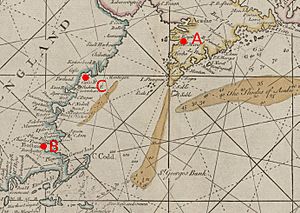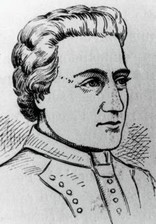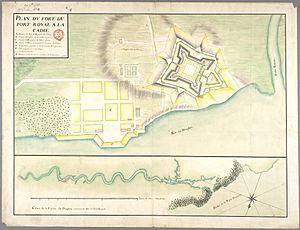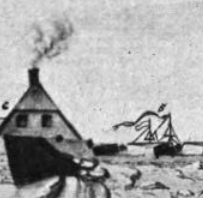Siege of Port Royal (1707) facts for kids
Quick facts for kids Siege of Port Royal |
|||||||
|---|---|---|---|---|---|---|---|
| Part of Queen Anne's War | |||||||
 Annotated detail from a 1713 map showing eastern New England and southern Nova Scotia/Acadia. Port Royal is at A, Boston at B, and Casco Bay at C. |
|||||||
|
|||||||
| Belligerents | |||||||
|
Acadian militia Mi'kmaq militia |
|||||||
| Commanders and leaders | |||||||
| John March Francis Wainwright Captain Charles Stuckley, RN Winthrop Hilton Cyprian Southack |
Daniel d'Auger de Subercase Bernard-Anselme d'Abbadie de Saint-Castin Pierre Morpain Pierre Maisonnat dit Baptiste Antoine Gaulin |
||||||
| Strength | |||||||
| 1,150 provincial soldiers (first siege) 850 provincial soldiers (second siege) |
160 troupes de la marine 60 Acadian militia 100 Wabanaki |
||||||
| Casualties and losses | |||||||
| 16 killed; 16 wounded; reports vary widely | At least 5 killed; 20 wounded reports vary widely | ||||||
The Siege of Port Royal in 1707 involved two attacks by English colonists from New England. They tried to capture Acadia, a French colony that is now parts of Nova Scotia and New Brunswick. Their main target was Port Royal, the capital (now called Annapolis Royal).
Both attacks were led by colonial militia, who were not very experienced in siege warfare. A siege is when an army surrounds a fort or city to try and capture it. The French troops at Port Royal, led by Governor Daniel d'Auger de Subercase, easily defended their fort. They were helped by local Acadians and the Wabanaki Confederacy (Native American tribes).
The first attack started on June 6, 1707, and lasted for 11 days. The English commander, Colonel John March, got his troops close to the fort. However, his engineer said they couldn't bring their big cannons close enough. Because of disagreements, the English forces left.
The second attack began on August 22. This time, the English couldn't even set up their camps safely. Governor Subercase's defenders kept attacking them, making it impossible for the English to get organized.
These failed attacks were seen as a big failure in Boston, where the English expedition had started. The leaders were even booed when they returned home. Port Royal was finally captured in 1710 by a much larger force that included British Army soldiers. This capture marked the end of French rule in that part of Acadia.
Contents
Why the Siege Happened
Port Royal was an important French settlement. It had been attacked many times by the English. For example, in 1690, forces from the Province of Massachusetts Bay captured it. But it was given back to France in 1697 by a peace treaty. It finally became British in 1710.
French Get Ready
When the War of the Spanish Succession (also known as Queen Anne's War) began in 1702, both the French and English prepared for fighting. Acadia's governor, Jacques-François de Monbeton de Brouillan, had already started building a strong stone fort in 1701. It was mostly finished by 1704.
After a French attack on Deerfield, Massachusetts, in 1704, the English in Boston decided to strike back. They raided Acadian communities like Grand Pré. There are different stories about whether they attacked Port Royal itself. Some say they thought about it but didn't. Others say a small attack happened.
In 1706, Daniel d'Auger de Subercase became the new governor of Acadia. He decided to go on the attack. He encouraged Native American groups to raid English settlements in New England. He also supported "privateers" from Port Royal. Privateers were like legal pirates who attacked English ships.
These privateers were very successful. They greatly reduced the number of English fishing boats on the Grand Banks of Newfoundland. They also raided some English towns along the coast.
English Get Ready
English merchants in Boston had traded with Port Royal for a long time, even after the war started. Some people in the Massachusetts government were angry about this. One merchant, Samuel Vetch, went to London to ask for military help against New France.
Meanwhile, Governor Joseph Dudley of Massachusetts decided to organize an attack on Port Royal using mostly colonial soldiers. He had suggested this idea before. His plan was approved in March 1707. Not everyone in the colony agreed with the plan. Some religious leaders supported it, while others prayed against it.

Massachusetts raised almost 1,000 soldiers. New Hampshire sent 60 men, and Rhode Island sent 80. A group of Native Americans from Cape Cod also joined. It was hard to find enough volunteers in Massachusetts, so some men had to be forced to join. Connecticut refused to help.
The English force was led by Colonel John March. It included 1,150 soldiers and 450 sailors. They had a fleet of 24 ships, including a large warship called Deptford.
First Attack
The English ships arrived near Port Royal on June 6, and troops landed the next day. Governor Subercase's defense force was ready. He had 100 regular soldiers and another 60 who had just arrived. He also had about 100 Abenaki Native Americans, led by Bernard-Anselme d'Abbadie de Saint-Castin. As soon as the English ships were seen, Subercase also called up about 60 local militia members.
Colonel March landed with about 700 men north of the fort. Another 300 landed to the south. Their goal was to surround the fort. Both groups landed too far away and spent the day marching. Subercase sent a small force to the south, but they were pushed back. Subercase himself led a larger group to the north. They set up an ambush where March's troops would cross a river. After a tough fight, the French defenders were forced back into the fort.
The English set up camps about 1.5 miles (2.4 km) from the fort. Subercase sent out small groups to bother the English soldiers who were looking for supplies. This made the English think more French soldiers were coming. The English tried to move closer to the fort. But their engineer, Colonel John Redknap, said their heavy cannons couldn't be brought safely into position. He said they would be too close to the fort's guns.
This led to arguments among the English leaders. On June 16, the English made a final attack. The French said it was a failed attempt to take the fort. The English said they were just trying to destroy some buildings outside the fort. The next day, June 17, the English got back on their ships and sailed away to Casco Bay (near present-day Portland, Maine).
Break in the Fighting

From Casco Bay, Colonel March sent a letter to Boston. He blamed the failure of the attack on the other English commanders. News of the failure reached Boston before his messengers. When they arrived, they were met by angry crowds. Colonel Redknap convinced Governor Dudley that he had followed his orders. So, March was generally blamed for the failure.
Governor Dudley ordered the fleet to stay put. He said all men must remain on board or face death. Dudley then sent more soldiers and three new leaders to oversee a second attack. Even with these orders, many English soldiers deserted (ran away). The force was reduced to about 850 men when it sailed back to Port Royal in late August. Colonel March stepped down, and Colonel Francis Wainwright took command.
Governor Subercase knew the English were coming back. He built more defenses to make it harder for them to approach. He also got help from a French warship called the Intrepide. Its crew joined the defenders, and the captured ships it brought provided needed supplies for the fort.
Second Attack
The English fleet arrived near Port Royal on August 21. Wainwright landed his troops about 2 miles (3.2 km) south of the fort the next day. They marched to a spot about 1 mile (1.6 km) north of the fort. This was where March had camped before. Subercase had built new defenses in this area.
On August 23, Wainwright sent 300 men to clear a path for their heavy cannons. But forces sent by Subercase attacked them. Using surprise attacks and fire from the fort's cannons, the French forced the English to retreat to their camp. This defeat really hurt the English soldiers' spirits. Wainwright wrote that his camp was "surrounded with enemies."
Things got so bad that on August 27, the English moved to a camp protected by their ships' guns. But this camp wasn't properly fortified. The English were constantly attacked by French and Native American snipers.
On August 31, Wainwright tried landing at another spot. Subercase himself led 120 soldiers out of the fort. About 70 men fought the English hand-to-hand with axes and musket butts. Saint-Castin and almost 20 of his men were wounded, and five others were killed. The next day, September 1, the English got back on their ships and sailed back to Boston. The French claimed to have killed as many as 200 English soldiers. However, English records say only about 16 were killed and 16 wounded during the siege.
What Happened Next
The English expedition's return to Boston was again met with boos and insults. Governor Dudley tried to make the failures seem less bad. He pointed out that many farms around Port Royal had been destroyed during the two attacks. Dudley also refused to investigate why the expedition failed, fearing he would be blamed.
Subercase worried that the British might return the next year. So, he worked to make the fort at Port Royal even stronger. He also built a small warship to help defend the colony. He convinced the privateer Morpain to keep raiding English ships. Morpain was so successful that by the end of 1708, Port Royal was full of prisoners from captured ships.
However, none of this saved Port Royal from the next attack. France didn't send much help, while the British gathered larger and better-organized forces. Samuel Vetch and others convinced Queen Anne to send military support for a new expedition in 1709. This attack didn't happen because the promised troops from England didn't arrive.
Vetch and Francis Nicholson went back to England. They again got promises of military support for an attack on Port Royal in 1710. In the summer of 1710, a fleet arrived in Boston with 400 marines. With the help of colonial soldiers, this force captured Port Royal after a third siege in 1710.



